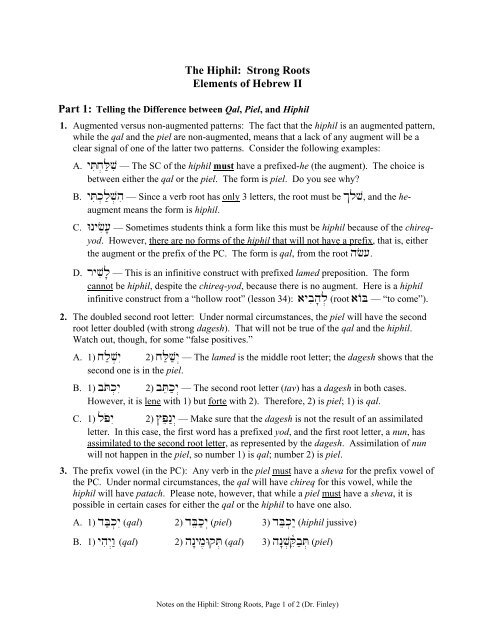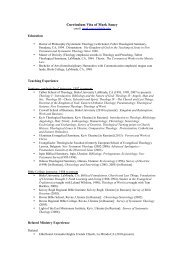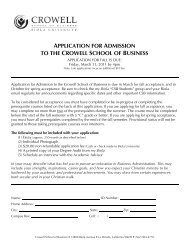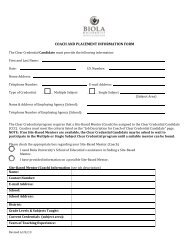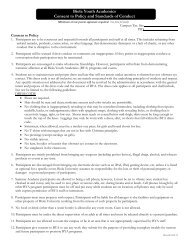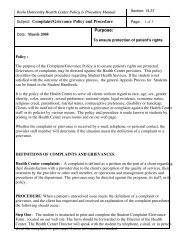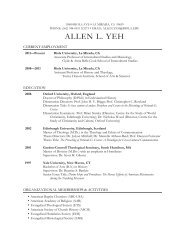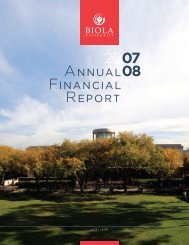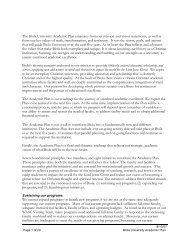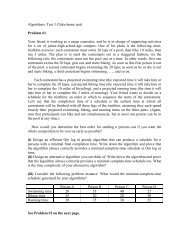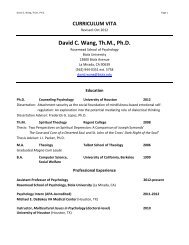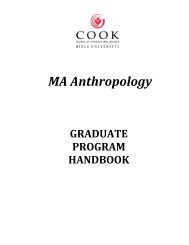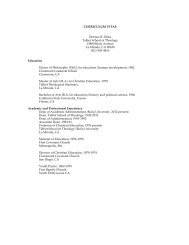You also want an ePaper? Increase the reach of your titles
YUMPU automatically turns print PDFs into web optimized ePapers that Google loves.
<strong>The</strong> <strong>Hiphil</strong>: <strong>Strong</strong> <strong>Root</strong>s<br />
Elements of Hebrew II<br />
Part 1: Telling the Difference between Qal, Piel, and <strong>Hiphil</strong><br />
1. Augmented versus non-augmented patterns: <strong>The</strong> fact that the hiphil is an augmented pattern,<br />
while the qal and the piel are non-augmented, means that a lack of any augment will be a<br />
clear signal of one of the latter two patterns. Consider the following examples:<br />
A. yTix.L;vi — <strong>The</strong> SC of the hiphil must have a prefixed-he (the augment). <strong>The</strong> choice is<br />
between either the qal or the piel. <strong>The</strong> form is piel. Do you see why?<br />
B. yTik.l;v.hi — Since a verb root has only 3 letters, the root must be $lv, and the heaugment<br />
means the form is hiphil.<br />
C. Wnyfi[' — Sometimes students think a form like this must be hiphil because of the chireqyod.<br />
However, there are no forms of the hiphil that will not have a prefix, that is, either<br />
the augment or the prefix of the PC. <strong>The</strong> form is qal, from the root hf[.<br />
D. ryvil' — This is an infinitive construct with prefixed lamed preposition. <strong>The</strong> form<br />
cannot be hiphil, despite the chireq-yod, because there is no augment. Here is a hiphil<br />
infinitive construct from a “hollow root” (lesson 34): aybih'l. (root aAB — “to come”).<br />
2. <strong>The</strong> doubled second root letter: Under normal circumstances, the piel will have the second<br />
root letter doubled (with strong dagesh). That will not be true of the qal and the hiphil.<br />
Watch out, though, for some “false positives.”<br />
A. 1) xl;v.yI 2) xL;v;y> — <strong>The</strong> lamed is the middle root letter; the dagesh shows that the<br />
second one is in the piel.<br />
B. 1) bTok.yI 2) bTek;y> — <strong>The</strong> second root letter (tav) has a dagesh in both cases.<br />
However, it is lene with 1) but forte with 2). <strong>The</strong>refore, 2) is piel; 1) is qal.<br />
C. 1) lPoyI 2) #Pen:y> — Make sure that the dagesh is not the result of an assimilated<br />
letter. In this case, the first word has a prefixed yod, and the first root letter, a nun, has<br />
assimilated to the second root letter, as represented by the dagesh. Assimilation of nun<br />
will not happen in the piel, so number 1) is qal; number 2) is piel.<br />
3. <strong>The</strong> prefix vowel (in the PC): Any verb in the piel must have a sheva for the prefix vowel of<br />
the PC. Under normal circumstances, the qal will have chireq for this vowel, while the<br />
hiphil will have patach. Please note, however, that while a piel must have a sheva, it is<br />
possible in certain cases for either the qal or the hiphil to have one also.<br />
A. 1) dB;k.yI (qal) 2) dBek;y> (piel) 3) dBek.y: (hiphil jussive)<br />
B. 1) yhiy>w: (qal) 2) hn"ym,WqT. (qal) 3) hn"v.Qñeb;T. (piel)<br />
Notes on the <strong>Hiphil</strong>: <strong>Strong</strong> <strong>Root</strong>s, Page 1 of 2 (Dr. Finley)
4. <strong>The</strong> characteristic vowel: Only the qal is capable of having a u-class vowel for the<br />
characteristic vowel. Considering the examples given above, this is why bTok.yI , lPoyI , and<br />
hn"m,WqT. must be qal forms (roots btk, lpn, and ~Wq, respectively).<br />
Part 2: Meaning of the <strong>Hiphil</strong><br />
1. <strong>The</strong> most common meaning for the hiphil is “causative,” that is, causing to do an action.<br />
This sometimes results in verbs with two objects (when applied to a transitive verb). It is<br />
different from the piel of stative roots, in that the latter implies to “make” a condition.<br />
Sometimes the hiphil is also applied to stative roots in a similar way, but the piel is more<br />
common for this. Waltke & O’Connor (Biblical Hebrew Syntax) follow Ernst Jenni’s<br />
discussion (Das hebräische Piel) of the difference between the hiphil and the piel in this<br />
idiom. For the piel the object of the verb does not contribute to the action in any way,<br />
whereas for the hiphil the object participates in the event. Thus,<br />
hk'(l'm.M;h; [r;zhi —condemn as guilty (caus.); act wickedly (intr.)<br />
bAj — to be pleasing, good byjihe — to do well, act right<br />
not attested<br />
!ymia/h, — to believe, trust in (i.e., regard as true)<br />
xl;c' — to be prosperous x:ylic.hi — to make prosper (caus.); to prosper (intr.)<br />
!qez" — to be old !yqiz>hi — to grow old, become old<br />
Notes on the <strong>Hiphil</strong>: <strong>Strong</strong> <strong>Root</strong>s, Page 2 of 2 (Dr. Finley)


